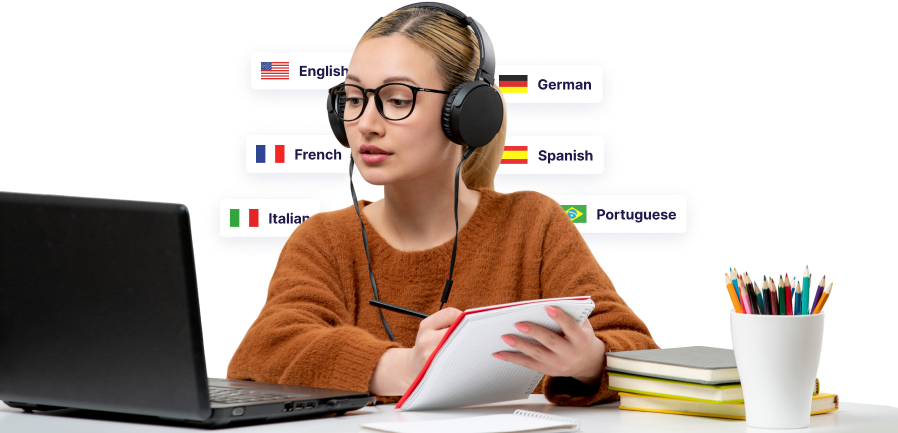ラピッド・トランスレート・チーム
人間の翻訳者は、翻訳サービスの最も人気のあるプロバイダです。彼らの翻訳は、その品質と専門性において、他のどの翻訳者よりも優れている。しかし、なぜ多くの人が機械翻訳者よりも人間翻訳者を好むのか不思議に思う人もいるかもしれない。
そこで、なぜ翻訳者が最高なのかを理解していただくために、翻訳者の仕事のあらゆる主要な側面について説明します。優れた言語サービスを通じて、翻訳者がどのようにグローバルなコミュニケーションを促進しているのかがお分かりいただけるでしょう。
翻訳者のコミュニケーションへの貢献を理解するために、ぜひお読みください!

目次
4種類の翻訳者
人間の翻訳サービスには、その専門性によってさまざまなカテゴリーがあります。以下に4種類の翻訳者とその特徴をご紹介します。
1.フリーランス翻訳者
フリーランスの翻訳者は独立して仕事をします。通常、単発の仕事やリテーナーを引き受けますが、料金は仕事ごとに発生します。フリーランス翻訳者は、実店舗のオフィスでは働きません。むしろ、自宅で仕事をし、質の高い翻訳をするために時間と注意を傾けることができます。
彼らは物理的なオフィスを欠いているため、フリーランスの翻訳者は、オンライン求人検索プラットフォーム上で自分のサービスをアドバタイズします。フリーランサーと契約する際には、彼らの仕事のスケジュールが柔軟であることを知っておく必要があります。したがって、双方が最適な納品時間に合意する必要があります。しかし、正式な仕組みがないため、時には説明責任を果たせないこともある。
資格のない人の中には、クラッシュコースを受講して翻訳者のふりをする人もいます。したがって、雇う前にフリーランサーの資格を確認することをお勧めします。
通常、米国翻訳者協会(ATA)のような国際的な業界団体に所属する翻訳者は本物です。
2.公式翻訳者
正式な翻訳者は、必要な学位や学歴を持ち、翻訳会社で働いています。ほとんどの翻訳会社は評判が良いので、人々は簡単にそのスタッフを信用します。
翻訳会社は、スタッフのスキルと能力を確認するために徹底的なチェックを行っています。そのため、慣用表現や国際的な翻訳基準を理解しているスタッフから最高の翻訳を受けることができます。
公式翻訳者は、個人や組織の特定の要件を満たすために各翻訳を調整することができます。ただし、その分、料金は若干割高になります。
3.公認翻訳者
公認翻訳者とは、翻訳した文書を認証することを認められた翻訳者のことです。通常の翻訳者よりも高いスキルを持つため、より専門的な仕事を請け負うことができます。
公認翻訳者は、翻訳を検証し、その正確性を確認するための機関の承認を持っています。そのため、認定翻訳者は、翻訳された文書内のすべての詳細が正しいことを確認し、クロスチェックします。
組織によっては、特に文書の認証翻訳を要求する場合があります。そのような場合は、認定翻訳者に連絡する必要があります。翻訳者は、資格証明書と署名とともに、正確性を証明する文書を発行します。
4.翻訳者ライセンス
ライセンス翻訳者と認定翻訳者は同じだと思われがちです。しかし、必ずしもそうではありません。ライセンスがなくても認定を受けることはできますし、その逆もあります。翻訳者ライセンスは、翻訳者が特定の管轄区域内で活動することを許可する政府当局からの承認です。
しかし、すべての管轄区域がライセンスを発行しているわけではありません。しかし、ライセンスを発行している地域にお住まいの場合、企業翻訳にはライセンスを持つ翻訳者が必要です。

翻訳カテゴリー
翻訳者は、さまざまな種類の翻訳を扱います。そのため、翻訳の種類を理解しておくとよいでしょう。そうすれば、機械翻訳技術ではなく、どのプロに依頼すべきかを判断できるようになります。
最も基本的なのは標準翻訳である。文書を断片的に読んで理解し、原文から訳文に変換する。
しかし、その変換は正確で完全なものでなければならず、文法的・文化的ニュアンスを考慮し、言語の偏りがないものでなければならない。
次に、法律、政府、医療、その他の重要な記録を検証する認証翻訳があります。専門家が認証翻訳を行い、署名、押印、証明書によって確認・検証します。
公証された翻訳も非常にユニークで重要です。国際的な法的手続きや入国管理局への申請に役立ちます。しかし、公証と認証は混同されがちです。しかし、翻訳者が公証を行うわけではないことに注意が必要です。
文書の公証手続きには2つの段階がある。まず、資格を有する言語の専門家が文書を翻訳し、公証人に手渡します。公証人はスタンプを押して文書の真正性を確認し、国際的に使用できる文書とします。
ローカライズされた翻訳もまた、独自のカテゴリーを形成している。ローカライゼーションは、翻訳と似ていますが、より強力です。ローカライズされた翻訳は、異なる地理的地域からの特定のターゲットオーディエンスに合わせてコンテンツを適応させます。
したがって、ローカライゼーションは、文体、通貨、象徴、社会規範などの細部を考慮する。
最後の大きなカテゴリーは専門翻訳で、多くのサブグループがあります。このカテゴリーは、分野、ニッチ、産業別の翻訳を扱います。例えば、医療翻訳、法律翻訳、特許翻訳などがあります。
専門翻訳は特定のトピックに焦点を当てるため、専門用語が必要となり、その扱いは非常に重要です。

人間対機械翻訳
機械翻訳は、人間の専門家を雇う代わりに人気のある選択肢です。機械翻訳を使用する人々は、機械ツールが即座に翻訳を提供する能力を誇っています。それは事実ですが、人間と機械ツールには長所と短所があります。
人工知能(AI)技術とディープラーニング・ニューラルネットワークによって、機械が翻訳を行う。ニューラル機械翻訳は、過去の翻訳の大規模なデータベースを使用して解釈するツールを訓練します。
しかし、言語は複雑で日々進化しているため、過去の翻訳データに頼るのは理想的ではない。さらに、機械ツールは文脈や考え方を理解せずにメッセージを解釈する。
機械翻訳は、迅速でコスト効率が高く、簡単に利用できる反面、不正確で創造性に欠ける。また、文化的な感受性や文脈・概念の理解にも欠けており、これらすべてが翻訳の品質に影響を与える。
一方、人の手による翻訳は、コストも時間もかかる。また、専門的な分野しか扱えず、主観的な翻訳になることもあります。さらに、資格のない翻訳者に出会うリスクは高いですが、その資格を確認することはいつでもできます。
優れた翻訳者なら、正確な仕事、創造的で的確な表現、最高の品質を保証します。さらに、翻訳者は急ぎの翻訳にも対応しているので、即日翻訳も可能です。
人間の翻訳は機械翻訳ソフトに勝るが、どちらにも目的がある。
例えば、予算が限られている場合、AI翻訳は即座に翻訳でき、場合によっては無料で利用できる。さらに、翻訳の精度を高めるためにプロにレタッチを依頼することもできます。
ただし、校正料金が高額になる場合があります。したがって、受信者が誤りを見落とす可能性がある非公式なコミュニケーションには、機械翻訳を使用するのが最善です。しかし、プロの翻訳者は、最高の外国語文書変換を提供するため、公式文書には適しています。
FAQ
プロの翻訳者について知っておくべき最も重要なことを説明しました。それでは、翻訳者についてのよくある質問にお答えしましょう。
人間の翻訳者はコンピュータ支援翻訳ツールを使うのか?
そう、翻訳者は翻訳メモリやコンピュータ支援翻訳ツールをよく使います。これらのツールは、大量の翻訳プロジェクトを同時に処理できるため、作業が簡素化されます。しかし、翻訳者はこのようなツールで翻訳結果を編集し、改善します。
人間の翻訳者は1ページあたりいくらで翻訳してくれますか?
プロの翻訳者の料金は、1ページあたり平均25~30ドルです。ただし、作業量や言語ペア、専門性によって料金は変動します。したがって、翻訳に必要な正確な金額を予測することは困難です。
すべての翻訳者はページごとに料金を請求するのですか?
いいえ、すべての翻訳者がページ単位で料金を請求するわけではありません。特にフリーランスの場合、1時間当たりの料金を設定しているところもあり、交渉の余地がある場合とない場合があります。とはいえ、依頼し、料金を比較し、予算に合う方を選ぶことができます。

Rapid Translateから翻訳者を雇う
翻訳者を探すときは、さまざまな翻訳の種類を理解するのが一番です。この知識は、あなたが必要とする翻訳者の種類を洞察するのに役立ちます。幸いなことに、良い翻訳者を見つけるために複数のプラットフォームを探し回る必要はありません。
Rapid Translateは、最も合法的な翻訳会社の1つ です。ご注文は、オフィスにお越しいただくか、オンラインウェブサイトをご利用いただくだけで、簡単に行えます。
弊社は国内外を問わず、60以上の言語で本物の翻訳者を派遣しています。納期は2~3日、価格もお手頃です。何をお待ちになりますか?
今すぐ翻訳サービスをご注文ください!




